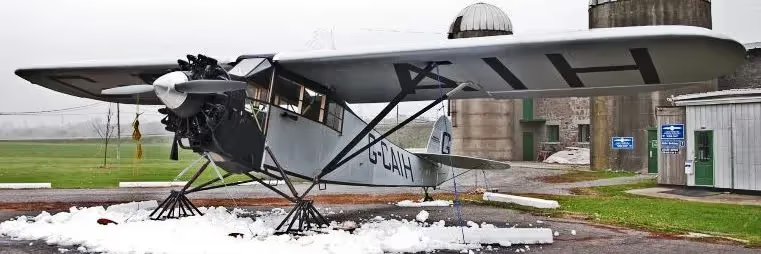Canadian Warplanes (6) Québec, Montréal, Musée de L'Aviation de Montréal/Montreal Aviation Museum
Musée de L'Aviation de Montréal/Montreal Aviation Museum
https://www.mam.quebec/discover-our-museum-2/

(Matthew Carson Photo, MAM)

Blériot XI, Le Scarabée, replica being restored. Reg. No. C-ISCA. (MAM Photo)
The Blériot XI was designed and built by Louis Blériot of France in 1909. In this aircraft, Blériot became the first man to successfully fly across the English Channel. Another important “first” was the 1910 flight over the City of Montreal by Count Jacques de Lesseps in his Blériot XI christened “Le Scarabée”. This epic flight was the first over a Canadian city. It took place during the Aviation Meet held in Pointe Claire, a suburb of Montreal. Members of the Montreal Aviation Museum , led by volunteer Richard Plante, build a full-scale reproduction of the Blériot XI from an original set of plans. (MAM)


Fairchild FC-2 Razorback, replica being restored. Reg. No. G-CAIH. (MAM Photos)
The Fairchild FC-2 was a pioneer “bush plane”, quite advanced for its time, featuring an enclosed, heated cabin, folding wings and adaptable to wheels, floats or skis. Canadian Vickers of Montreal built twelve of these aircraft under license from the Fairchild Aviation Corporation based on Long Island, New York.. It was the first of a family of aircraft, some of which were designed and built in the 1930s by Fairchild Aircraft Limited of Longueuil, Quebec.
The FC-2 was involved in some of the first airmail deliveries and was piloted by the famous Quebec aviator Romeo Vachon, It was also used extensively as a photo survey aircraft, a role for which it was specifically designed, with provisions for a downward-looking camera itself designed by Sherman Fairchild. The MAM’s example is a reproduction built by volunteers and depicts an FC-2 flown by the founder’s father – Hubert Pasmore. He was a pilot for Fairchild Aerial Surveys of Canada Ltd. based in Grand-Mère, Quebec. (MAM)

Bristol (Fairchild) Bolingbroke Mk. IV, RCAF (Serial No. unknown), being restored. (MAM Photo)
Fairchild Aircraft Limited build over 600 of these twin-engine bombers during the Second World War. This aircraft was rescued from a farmer’s field in Western Canada. Restoration work is underway, and it will be finished in the Coastal Command livery representing Bolingbroke number 9066, a “Boly” that served in several squadrons on both coasts and in the British Commonwealth Air Training Plan. (MAM)

Curtis-Reid Rambler, Reg. No. CF-ABQ. (MAM Photo)
The Curtiss-Reid Aircraft Co Ltd was formed in December 1928 when the New York-based Curtiss Aeroplane and Motor Company took a controlling interest in the Reid Aircraft Company of Montreal. The Canadian company had itself only been set up in February of that year by former Canadian Vickers designers William T Reid and MJ Berlyn. Together, they designed a two-seat sesquiplane as a club trainer, private tourer and light transport aircraft. This aircraft first flew at Cartierville (Montreal) on September 23rd 1928 piloted by Martin Berlyn and was named the Reid Rambler at a demonstration ceremony on 29 September.A total of 45 examples were built in different variants. The famous top-scoring Canadian fighter ace of the Second World War ‘’Buzz’’ Beurling from Verdun, learned to fly on the Rambler.

Nimmo NAC-SB-1 homebuilt. (MAM Photo)

Noorduyn Norseman, being restored. (MAM Photo)

Canadair CF-104 Starfighter (Serial No. 12704), over RCAF Station Cold Lake. (RCAF Photo)

Canadair CF-104 Starfighter (Serial No. 12704), being restored. (MAM Photo)
Fleet 80 Canuck (Serial No.), being restored. TBC.
Stinson 10A Voyager (Serial No.), being restored. TBC.
.jpg)
2024, Canadian Warplanes II





